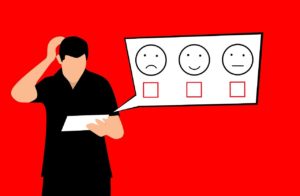TLDR: Do Your Customers Trust You?
(What is trust, how do you measure it, and why is it so important?)
Is your company doing better or worse in terms of maintaining and building customer Trust right now? Sadly most companies can’t even answer that question. Yet Customer Trust is a far more important metric than Customer Satisfaction, Net Promoter Score or any of the other measures CX/CS Professionals commonly track. In fact, our company has been offering a free service to monitor customer Trust since early April.
Trust is far more important than Satisfaction for several reasons which I’ll get into below. But before that, lets look at exactly what trust is, and how it can be measured accurately and consistently. Later this week I will be sharing ‘5 Tips on how your Customer Experience department can build customer trust right now’. However, before we start to work on improving Trust, I think it is important to understand just what it is, and why it is so important.
‘Trust’ in customer interactions – What is “Trust”?
Emotions are an important area of study among psychologists. While there is disagreement about the significance and number of emotions most psychologists seem to agree on the 8 major emotions eloquently illustrated in Plutchik’s wheel of emotion.

The wheel attempts to juxtapose emotions so that they appear opposite each other in the wheel. As you can see, ‘Trust’ appears opposite ‘Disgust’ in the wheel. However, technically ‘Trust’ is different than most other emotions, as it consists in large parts of cognition related to experiences. For the purposes of this post though I will refer to customer ‘Trust’ as a general topic that can be measured in at least two ways, either as present or not present, as well as a more nuanced and valanced measure which can range somewhere between complete ‘Trust’ to complete ‘Distrust’ for a business/service.
We can rather accurately measure increases or decreases of trust among customers over time, or measure differences in trust between customer segments, specific product mentions, or between brands as a whole, as well as in terms of how various sales or customer service agents may be adding or detracting to the level of trust the customers they interact with have for your business.

How we think about Trust (in people, products and Brands)
Trust is made up of several parts.
Do you believe XYZ Corp can be trusted? Can Joe Smith be trusted? Either consciously or unconsciously we are evaluating whether individuals and organizations are trustworthy every day. Are they honest, are they fair, are they acting with our interests in mind, are they benevolent? Competence also plays a role, i.e. confidence is a type of trust. Confidence in the product/service that it will be reliable and work as expected.
Trust can be easily influenced by memory, both by prior experiences as well as what you have heard from others or on the news. Trust does not change as quickly as other emotions. Someone can go from satisfied to dissatisfied in an instant. Of course, there can be an immediate reaction with trust, but because trust involves cognition, we will evaluate it, and so even if something bad happens to you as a customer in a situation, your trust can still be recovered.
As trust is more complex than other emotions, it is harder to measure at one point in time at the individual level. It is something that tends to be in flux, either helped or eroded over time. It will be slightly influenced on the emotional side, but there will be a lot of thought processes involved trying to find reasons why a product is trustworthy or not.
At the individual level, trust is even tied to personality types, as it develops as thoughts and feelings that people have. For instance, during early stages of child development (birth to 3 years), if care is reliably available when needed, then these humans are more likely to trust others and have stable relationships. Without going into detail, we can extrapolate to the fact that some people are more trusting than others… And while there are more detailed segments of the population in psychology (technically 4 levels), we can generalize to just two segments, the larger group consisting of most people (60-70%) who are more secure in terms of trust, and the rest who are more distrustful naturally. Whether we tend to be naturally more or less trustful, trust is a critical part in any business relationship.
Measuring Trust

The good news is in business we can be less worried about the individual personality types and can more easily and quickly focus on trust in ways that can improve communication across our customer touchpoints. While trust can be measured in survey Likert scale ratings, measuring trust in verbal or written communication is in many ways more practical, and has a long history in the field of psychology.
At OdinAnswers we have been measuring ‘Trust’ in customer comments coming from various touch points for quite some time. Importantly, we’re not talking about just explicit mentions of trust such as “I trust your company completely”. While explicit mentions of trust like these are absolutely included in our models of Trust, the far larger component is made up of other more nuanced and tacit exclamations that serve as signals identifying Trust. Thus our validated ontology considers use of topics ranging from ‘Accuracy’ to ‘Virtuousness’, their synonyms and inflections, as well as more recent terminology like ‘alt right/left’ and ‘fake news’, as well as their contextual use in terms of whether or not they are negated. In the end, used correctly, this provides a much more flexible and powerful measure of trust than any Likert scale ratings, as it allows us to continuously scan customer communication, reading ‘between the lines’ for increases or decreases, and even in context to specific business issues.

So What? Earning and Keeping Customer Trust – The Customer Experience
Whether they know it or not, most companies are relatively good at ‘Trust’. Perhaps implicitly we all know how important it is as a first step in convincing a customer to even consider doing business with us. Yet it is important enough to consider explicitly, and companies that do so are much better for it.
If we think about it, it is a bit surprising how good some companies are in their solutions that either fix customer problems or avoid them proactively. Take stores that due to COVID-19 have been allowing returns for 6 months rather than 30 days. Instead of penalizing people during this critical time, they are helping them. Maybe customers do not want to go to post office for the next several weeks. When you see a company helping you your belief that they are fair and competent is increased. Trust increases.
Take travel and hospitality as another example, some airlines are allowing people to cancel and change flights without fees, even though this was not mandated. Instead it is something that was started for the customers benefit so instead of increasing stress it decreases it. Decreasing friction, increasing trust, leads to purchases.
Simply sharing information with your customers, explaining to them that you understand their needs, that you are doing something new, changing policies to help customers, if executed correctly, and monitored using natural language processing (text analytics) you should easily be able to link to and see how these changes in policy lead to positive changes in trust.
Take an even more common example of grocery stores during the past several weeks. Posting government safety notices, encouraging masks, tape measurement to maintain 6 foot distancing, allowing x number of customers in at a time. In aggregate these changes tell customers that the store is trying to be responsible, is capable, and the net is a positive trust builder on both a conscious and subconscious level. If measured, changes like these will be reflected in your customers minds and feedback comments and can be measured directly through text analytics, and ultimately in revenue as well as the even more valuable long term loyalty.
Just the fact that a business is open and continues to serve customers in whatever way they are able to during a crisis serves to increase trust. For those of us managing via Customer Satisfaction or Net Promoter Score, you can expect trust to be highly correlated with satisfaction and NPS.
In terms of customer service/support you will find that people are more forgiving as a sign of gratitude. Appreciation is a component in our trust ontology. Customers think “you are not abandoning us in this difficult time”. Even though rationally each business wants to stay open for its own egotistic reasons, it is still perceived very positively due to the contrast with other businesses which are closed. Thus, those businesses that do stay open are appreciated for it.
People are more likely to do good things and care about people (and businesses) than they normally would during crisis times like these (see my post which referenced September 11). While we can initially generate gratitude and Trust by simply remaining open in times like these, there is so much more we can do.

Importance of Trust – More important than Customer Satisfaction!
Trust is closely related to long term relationships and commitment. So, it is a critical part of long-term loyalty and repurchase. Satisfaction, is far more volatile. You may be disappointed in terms of satisfaction and continue a relationship (business). This is why Trust is so much more important than satisfaction (though the two are of course related), and should therefore be measured, tracked and understood. A customer can always be made happy again, but without Trust, the relationship ends. You will not get another chance.
Thanks for taking the time to follow me on just one of the many important customer dimensions that can be tracked and measured in customer communications. As mentioned, Trust really is more important than Customer Satisfaction or Net Promoter Score as it is not something ephemeral. It is lasting, and something that can be built up over time.
Check back Thursday for my next post ‘5 Tips on how to build Trust’ with your customers during this current time of crisis.
In the meantime I welcome your comments or questions below. If you would like more information on how OdinAnswers can help you understand Trust and other key issues in your customer communication and feedback feel free to contact us here.
@TomHCAnderson
Chief Research Officer
OdinAnswers
[NOTE: This post originated from a conversation I had with Lenny Murphy of The Greenbook who was interested in the free for COVID Customer Health Monitor. He pointed out how important one of our tracking themes ‘Trust’ is for many brands he has been speaking to. While my training is not in psychology, OdinAnswer’s ontology for trust and other key emotions in text data was implemented and continues to be honed by PhD’s in Psychology, and I consulted with one of our lead data scientists and PhD in Psychology, Dr Gosia Kolling before writing this post.]
Images Sourced from Pixabay.




Tom, I must admit your blog title threw me a bit with apples and oranges comparison….charm is more important than an SAT score. This topic has been well researched. Early work by Leonard Berry at Texas A&M University found that the attribute most valued by customers was reliability–do you keep your promise. Len has written several best-selling books on the topic. Martha Rogers and Don Peppers’ book, Absolute Trust, provides more scholarly research on trust as a distinguisher. Service Certainty by Jason Forrest and Paul Cardis examine similar findings. All agree unless the customer trust you, all other features are secondary.
PS. Will be posting part 2 here, on 5 ways how CS teams can build Customer Trust shortly. Look forward to any comments or questions.
Tom –
Where CX (and EX) are concerned, truer words were never written. Trust has an emotional and subconscious base, is earned over time, and builds commitment and loyalty behavior. At best, as a metric CSAT is transitory and attitudinal not well connected to actual behavior, and metrics like NPS and CES are, historically, so full of deficiencies and questionable actionability and value that they are almost not worth the space to mention them.
Here’s what I wrote about trust in a 2014 CustomerThink post:
“Trust is at the core of customer focus and customer centricity. Winning trust means creating rapport, understanding what’s important, communicating openly, and providing what customers want from an emotional, as well as a basic competence, perspective. Increasingly, driving perceived value and successful relationships with customers will require that organizations take a more proactive, inclusive, and human-centered approach. Keeping that trust means providing proactive, consistent delivery. It means going the extra mile to exceed customer expectations, so that the investment in faith that customers have made is justified. Consumer trust isn’t a vague or abstract concept. It’s real and it monetizes. Trust is the key factor that drives customer loyalty, and repeat business, so has quantifiable bottom-line impact.”
For me, that pretty will sums up what trust represents – to customers, to employees, and to organizations.
Trust does lead to satisfaction and a better experience. and is picked up in the NPS score.
Trust can also lead to value.
None of these are mutually exclusive. I am not downplaying the importance of trust. But neither can you downplay the other factors. Trust alone is not enough. One needs a price-benefit that is favorable, and trust improves the benefits
Tom,
Excellent article that focuses on the elephant in the room.
I would say that Trust is an antecedent to NPS and also partly to satisfaction.
We tend to focus on outcomes, without realizing that the outcome is dependent on the process, which is trust.
You talk about reliability, and competence, but these are just the reactive side of trust. They are expected. I would go one step further and look at the proactive side of trust, what Peppers and Rodgers call Trustability, can I trust this supplier to do the right thing for me. Will they do it without my asking or even knowing about it?
I disagree that most companies are relatively good at trust. according to the customer rage studies, more than 50% of companies do not respond to customer complaints. Where is the trust? Why do I have to prove to companies that I had a dissatisfying experience?
In the US, 90% of people do not associate the word trust with the word business. In Australia, it is 95%.
We need to build up our trust levels, especially in these trying times. It needs to be our organizational compass.
According to an April, 2020 Edelman Trust Barometer survey, 90% of respondents “want companies and brands to do everything they can to protect the well-being and financial security of their employees and suppliers, even if it means suffering big financial losses during the pandemic. The penalty for companies that put profit ahead of people is severe, with 71% of people saying that this will erode their trust in a business forever.” Yikes! Lots of companies talk the “people-before-profits” talk, but they surely fail at “walking the walk.” I won’t mention any names.
We cannot hold meaningful conversations about corporate trust without including intent in the discussion. Without understanding that, we miss the linchpin in buyer-seller relationships. We must have clarity on what vendors are truly after in customer relationships. And above all, vendors must be honest with themselves about their intentions.
In capitalist economies, vendor resources and activities are unabashedly directed at earning revenue. No apologies necessary. But achieving that objective can result in strategies and tactics that range from patently exploitative (to stakeholders like employees and customers), to mutually beneficial.
Before the advent of Blockchain, trust was considered a de facto element in every buyer-seller relationship. Today’s marketers keenly understand this, which has had the unfortunate effect of demoting trust into a marketing schtick, stripping away what makes trust genuine in favor of what promotes its appearance. Most customers can see right through this. Little wonder they’re disillusioned, as the survey results suggest.
To avoid having ‘trustworthiness’ lose its meaning and devolve into a tinny marketing slogan, we need to layer further qualifications on what makes trust happen. The important thing to remember is that intent is under a vendor’s full control, whereas trust can only be granted by the reciprocal party. This is why trust-seeking companies must provide visible evidence that:
1) they will protect customers from experiencing harmful outcomes
2) they won’t intentionally mislead or misinform customers
3) they will live up to their stated values
One confusion that merits discussion is how much trust is enough? Our immediate assumption is that more trust is better. But how much trust is truly necessary? As a vendor, I expect my customers to inform themselves. On the other side, as a customer, I know that a core mission of a selling organization is to persuade me to buy. Therefore, it’s incumbent on me to inoculate myself to some of the messages, actions, and claims that most sales-minded vendors would likely take. Consequently, in B2B sales, my “trust bar” is somewhat lowered. On balance, I expect – and accept – that a vendor will ultimately act in their own best interests. Since they can’t possibly known all of mine, it’s hard for me to expect them to consider all of them.
I realize there’s a lot packed into my commentary. Trust between trading partners is difficult to “unpack.” For me, intent is large. When I sense their business purpose is “maximizing return to shareholders,” the stage has already been set. I will not trust, not matter what the company does, and no matter how hard they try.
Thank you Tom for the meaningful sharing ! I love it !
The business ralationship needs 3C : Comprehend, Cherish and Credit (Trust). Trust plays key factor for moving to buying step !
What I really like about the focus on trust is that it is relationship based, as opposed to the transactional focus of metrics like NPS, CSAT and CES. This alone makes it far closer to measuring real loyalty.
Great discussion. ‘Trust’ get surprisingly little coverage in a CX world where “are you satisfied?” and “would you recommend?” are questions that dominate surveys.
My family and business recently left Wells Fargo after nearly two decades. Why? We didn’t trust them any more. We didn’t have any evidence that they did anything directly to our accounts, but the scandal over creating fake accounts, and the way they treated (abused) employees to make their numbers was just too much.
I can’t remember ever getting a survey directly asking whether I trusted the company. I wonder how the answers would correlate with CSAT and NPS.
Bob –
Our CX surveys always include multiple questions addressing levels, and consequences, of vendor trust. What these studies consistently find is that antecedent metrics like CSAT, CES, and NPS provide little guidance or actionability re. the importance of trust and how to leverage or repair it: https://beyondphilosophy.com/customer-experience-research-morphed-focus-change-cognitive-rational-emotional-relationship-driven/
Hi Tom,
Thanks for a great post, and for starting a meaningful discussion. (And thanks Bob for providing the platform.) All contributors have made great points.
Many years ago – and please forgive me because I cannot remember nor find the source – someone posited that trust comprises four key elements: reliability, acceptance, openness and congruence. If I may, I’d like to briefly share a couple of points:
RELIABILITY: Always comes out tops, because keeping promises to customers, whether they are expressly stated or implicitly understood, is vital. All the research from Parasuraman on confirms this.
ACCEPTANCE: This is what Carl Rogers called “unconditional positive regard,” and in today’s world of shockingly poor leadership, it’s all too easy to judge people on skin color, ethnicity, religion, gender choices, accent, political affiliation and a host of other characteristics. I recently did a presentation in the UK where one of the delegates came to me afterwards to say thanks, and embarrassedly said that she didn’t get the first 15 minutes of my presentation because she thought my South African accent “showed I had no credibility.” Accepting customers as they are is hard, but essential for building trust.
OPENNESS and CONGRUENCE: both relate to something similar. If we imagine every human being is unique, then what is visible to everyone else – the tip of the iceberg – is what we say and what we do, or our words and actions. But hidden below the waterline are the really important things: our thoughts and feelings, and our needs and values. These deeply influence trust because openness is about doing something pretty scary: exposing some of the hidden stuff. This can make us vulnerable.
But congruence (or straightforwardness) is also vital because if our behavior doesn’t match out thoughts, feelings, needs and values, we are going to get caught out. This has been so obvious in so many corporate crises in the past ten years that it’s amazing that companies still think they can get away with lying and obfuscation.
Of course, measuring these characteristics is also more difficult, and that’s why I love the work done by Colin Shaw and Beyond Philosophy.